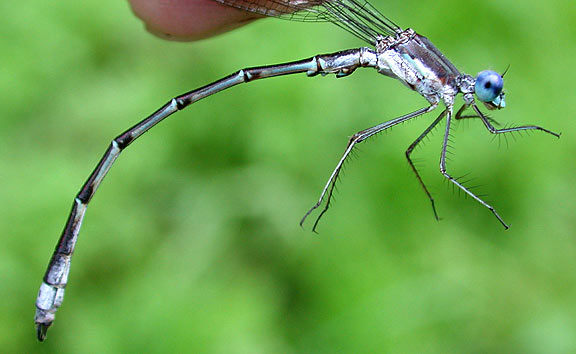Sweetflag, Southern, & Northern (formerly Common) Spreadwing males (Lestes forcipatus, australis & disjunctus)
This group of spreadwings are among the most difficult to separate and identify. Males of this group are very similar in appearance: the top of the thorax is dark and non-metallic, appearing brownish black. All three species may have pale green shoulder stripes but these are often reduced or absent in many individuals. The sides of the thorax are pruinose white. The abdomen is dark above and upon maturity, segments 9 & 10 become completely pruinose white. Eyes and face are bright blue. As they age their patterns may be increasingly obscured by pruinosity. Because of their similarity and variability of pattern, these species have to be separated in the hand using magnification.


Males of these species have to be separated by their terminal appendages. The cerci of all three species have basal and a distal teeth. On the Northern, the distal tooth is large, sharp and as long as the basal tooth. The distance between the teeth is short. The cerci of Southern and Sweetflag are similar. In both species, the distal tooth is shorter, and often blunter than the basal tooth which is long and sharp. The distance between the teeth is also longer than that of the Northern. These differences in the cerci make it possible to identify the Northern.
The paraprocts or inferior appendages also have suble differences in shape. Northern and Southern are most similar, but the shaft of the Southern has a more pronounced curved and they are more distinctly narrowed in the middle. Paraprocts of the Sweetflag are straight and thin, their middles slightly narrowed only sometimes. These differences can be useful but are subtle and difficult to see well even in the hand.

I find this character the most useful to separate the Southern from the Sweetflag in the hand. The apical notch is found at the tip of the abdomen on the top of segment 10 and can be viewed with a handlens. The Sweetflag has a wide notch that often spans one third of the width of the segment. Its width makes the notch appear very low. The notch of the Southern is narrower and appears more pinched, while the Northern has a even narrower notch that is strongly pinched. There are additional characters such as the length and shape of the anterior laminae which are useful in separating the species but the apical notch is easier to observe on a living specimen. But take time to check all characters. These characters are both tiny and subtle, and observing them in the hand takes practice and patience. For these difficult species it may prove easier to make the identification from a collected specimen.